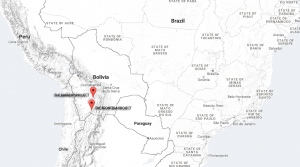
Bolivian Stable Economy Tops Growth in South America
Besides Luis Arce picture please replace copy with: “The stability of the Bolivian economy made the country rank as number one in economic growth in South America in 2016, an achievement that the Government plans to maintain this year, based on dynamic financial activity and social protection programs.”
Bolivia reported a 4.3 percent increase in the Gross Domestic Product (GDP) in 2016, and the Central Bank of Bolivia (BCB) projects an increase of close to 4.7 percent with inflation staying below 5 percent in 2017.
According to Economy Minister Luis Arce, productive sectors such as mining and construction industries contribute significantly to the development of the country, where the international crisis has been felt elsewhere.
In the monetary policy report presented here, BCB chief adviser Raúl Mendoza highlighted contributions of industries such as oil refineries and cement production, driven by growing demand from the construction industry. Energy, insurance, real estate and services to state enterprises are other leading sectors.
Mendoza also highlighted the good performance of transport and communications, as well as public investment aimed at increasing and improving the operating conditions of roads and airports in the country.
The road construction plan is one of the key priorities of the Bolivian government in order to integrate the different departments and regions. The president of the Bolivian Highway Administration Company (ABC), Noemí Villegas, announced for the first quarter of 2017 the beginning of the construction of a double highway in El Sillar stretch, located on the road that connects Cochabamba with Santa Cruz.
According to ABC data, the country plans to reach 2020 with an investment of 11 billion USD in new roads to interconnect regions.
In the last 10 years, more than 50 percent of the roads were paved and more than 4.3 miles of bridges and tunnels were built, the report said.
The government has also made large investments to expand electricity generation capacity through various projects such as the combined-cycle plants of the Guaracachi Company and the wind energy plant Qollpana.
According to the president of the National Electricity Company of Bolivia, Eduardo Paz, this company will have a budget of over 1.4 billion USD this year with the aim of expanding energy services in the country.
Paz reported that the Misicuni hydroelectric plant, solar farms in Uyuni, Yunchará, Sena and the expansion of the solar field installed in San Matías, in the department of Santa Cruz, are some of the main projects.
The Bolivian Government’s Economic and Social Development Plan envisions investments of more than 800 million USD over the next four years (2016-2020) in the construction of thermoelectric, hydroelectric and biomass plants, and in the solar and wind power generation, which will increase power capacity to 11,384 megawatts, thus turning Bolivia into an energy center in South America.
On the other hand, Bolivia‘s Energy Minister Rafael Alarcón referred to the possibilities of exporting energy to neighboring nations like Argentina, Brazil, Peru and Paraguay.
We have made progress in signing contracts with the Argentine company Cammesa, which foresees the transfer of 80 to 120 megawatts and we hope to have the means to carry out that project in 14 or 15 months, Alarcón said.
The laying of transmission lines between the electrical substations in Yaguacua, Bolivia, and Tartagal (Argentina) will require about 28 million USD in loan from the Central Bank.
Alarcón stated that the project will conclude in 2018, because its construction depends on the purchase of equipment, conductors and lines. We also plan the send 120 Megawatts to Paraguay if the electric integration with this nation materialized, he said.
The economic contribution to social projects has also been crucial for the Bolivian economy. In coordination with the Executive Body, BCB finances several national strategic public companies (EPNE) and contributes to the National Fund for Regional Development (FNDR).
The country also maintains transfers for the payment of the Juana Azurduy Bonus that is given to Bolivian women from pregnancy until the child turns two, for a total amount of 266 USD.
The country also pays its contribution to the Cable Car, the world’s longest and highest cable transportation system, which rises more than 4,000 meters above sea level and is a tourist attraction in the city of La Paz.
The president of the Central Bank of Bolivia, Pablo Ramos, ratified that this economic stability will continue this year, supported by a financial strategy that seeks to maintain strong the internal purchasing power of Bolivians, redistribute income and maintain the balance between supply and global demand.
He also said that the BCB will continue consolidating the national currency to preserve the financial system safe and sound and mitigate negative external factors.
See original article


